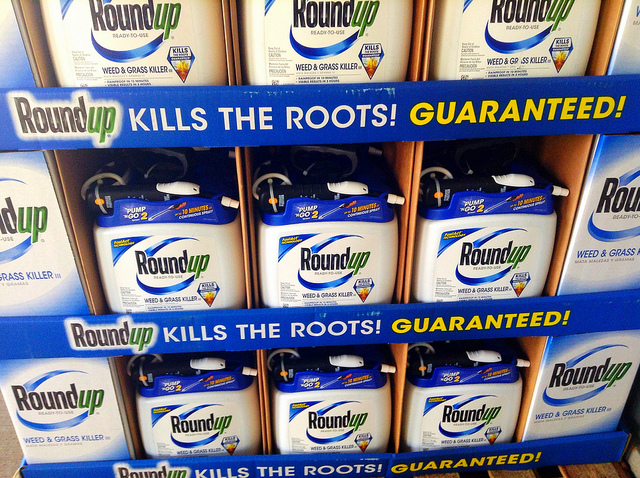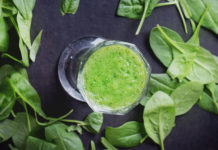This spring the World Health Organization and International Agency for Research on Cancer (IARC) assessed the carcinogenicity of five organophosphate pesticides and herbicides. Their biggest finding, glyphosate, found in common household herbicides was determined to be a “probable carcinogen” (Class 2A). The research, published in The Lancet Oncology, relies on studies conducted on the chemical over the past few decades and has found that glyphosate is “probably carcinogenic to humans” and can cause non-Hodgkins lymphoma and lung cancer in humans, as well as hard evidence of causation in animals.
Glyphosate, an herbicide, is the main ingredient in Monsanto’s Roundup line of weed killers, and was deemed safe by the EPA. It has increased in popularity and usage over the last two decades. Popularity has also increased due to genetically engineered crops created to withstand the herbicide. The EPA has also raised the allowable limits for glyphosate in food in 2013. Currently, the allowed level in teff animal feed will be 100 parts per million (ppm); oil seed crops, 40 ppm.
Dow Chemical has a new product called “Enlist Duo” that also uses the main component of glyphosate, and is marketing it as the new tool for farmers to battle herbicide-resistant weeds. These types of development could mean big changes for GMOs, farmers, and your health.
How are People Exposed to Glyphosate?
Glyphosate is currently the herbicide with the highest global production volume. This chemical is the reason behind the dangers of using Roundup. Agricultural use is the largest worldwide, but it is also used in forestry, urban life, and home applications. People are exposed through the air during spraying, in ground water due to absorption, and in food treated with the herbicide.
Much of the acute exposure happens at the farm level with farm workers in the United States. As many as 20,000 farm workers become sick each year from pesticide and herbicide exposure, including glyphosate. The CDC reports that agricultural workers, groundskeepers, fumigators, and a variety of other occupations are at the highest risk for acute exposure.
Another problem with glyphosate exposure is the increase in antibiotic resistance in individuals exposed to livestock who have been treated with antibiotics along with consuming feed containing the herbicide glyphosate. Both antibiotics and glyphosate in livestock have been linked to the decrease in healthy gut bacteria in humans. Glyphosate has been shown in this study to suppress the growth of beneficial bacteria and instead lead to the overgrowth of pathogenic bacteria.
Over the past 10-15 years, an in vitro study has been carried out to investigate botulism in cattle. These findings concluded that botulism-causing bacteria was overgrown in cattle exposed to herbicides containing glyphosate. As the cattle or poultry eat their feed, they ingest large amounts of the herbicide, which is contributing to their illnesses. These widespread cases of glyphosate exposure are a significant factor in the contamination of poultry and cattle products with pathogenic salmonella, botulism, and E.coli strains. This contamination can make human consumers extremely ill and be potentially fatal in certain individuals.
Research by Samsel and Seneff in 2013 hypothesized that celiac disease and gluten intolerance were increasing due to the reduction of healthy gut bacteria from the exposure to glyphosate. They focused on links to these two diseases specifically but also other health issues including ADHD, autism, Alzheimer’s, birth defects, and cancer.
Many scientists are taking a closer look at the modern day food supply and the potentially harmful effects it is having on increasing disease. Despite popular belief, many diseases once believed to have genetic origins may be products of chronic toxin exposure. By reducing exposure to toxins, the incidence of many of these diseases may be reduced.
How to Reduce Exposure
The risks from both direct exposure and chronic exposure in foods are a major concern. Knowing this, there are ways to decrease the exposure to you and your family throughout your daily lives. Taking these precautions can help to decrease risk for harmful and life threatening illness. Children are much more at risk for direct exposure since they play on floors, put things into their mouths often, and are placed closer to outdoor elements such as lawns and yards where herbicides and pesticides are common. Individuals with asthma or chronic diseases are also greatly affected through direct exposure. So what can you do you decrease exposure and stay healthy?
1. Buy locally grown and organic fruits and vegetables.
Knowing where your food is grown and what is used while growing food is a very important step to reducing exposure. Local farmers are able to tell you what types of chemicals are used, and if any are used during growth.
Eat organic whenever possible. Organic produce can be more expensive, but if you try to buy the foods that your family eats most, it can help your budget and your health.
2. Wash produce before eating.
Using cold water alone is not enough when you are trying to reduce the amount of contaminate that could be on the produce you eat. Many safe products are available to remove chemical residue from produce. I recommend using Veggie Wash, an all natural fruit and vegetable wash. Make sure to wash produce for 5-10 seconds and use a produce brush when handling items that need to be scrubbed. Keep in mind that while this is very effective at reducing what is on the produce, it does not affect what is in the produce.
3. Grow your own produce!
A backyard garden or patio garden can provide much of the required produce for a family of four. Both a fun and healthy activity for children and families, and a productive way to cut produce costs, a garden allows you to control the types of both herbicide and pesticide to which you may be exposed. Perennial crops like asparagus, blueberries, and strawberries will yield produce for years without much extra work. You may want to consider this neat device for growing produce, especially if space and time are limited:
4. Use non-chemical ways to control weeds and pests in your garden.
For your garden, building healthy soil, pulling out weak plants along with the weeds, and using seaweed mulch or spray can help to keep your garden non-toxic. Here are some other ways to help to build a healthy and safe garden for your home. Although the article addresses garden pests, I believe you will find it quite useful for not only for insect control but weed control as well.
5. Have a no-shoe policy in your home.
Chemical fertilizers and herbicides (and germs as well!) can be transferred onto the bottoms of your shoes and then walked around inside your home. By limiting the amount of tracking within your home, this can help to reduce the possibility of exposure to children and animals. It also helps to cut back on, or completely eliminate, harsh lawn chemicals from finding their way into your home.
Overall, knowing where and what is in your food is the most important step to reducing exposure. Be an informed consumer about potential environmental risks and chemicals being used in daily items thought to be safe for humans. The world we live in today is filled with toxic and harmful items. Know what to look for, what to avoid, and take steps to minimize exposure to toxic chemicals.
—
Photo credit: Mike Mozart / CC BY 2.0









